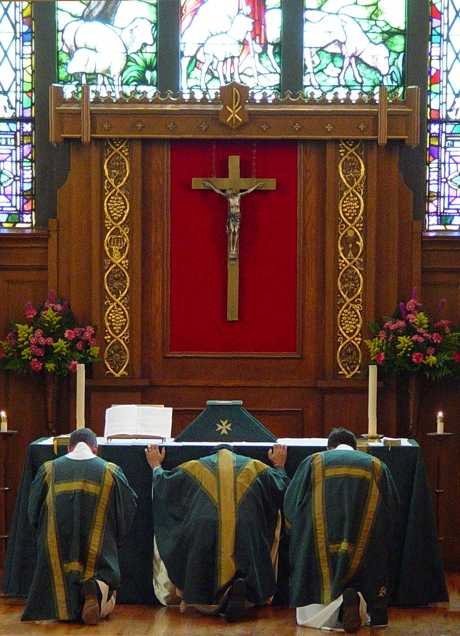As the discussion expanded several noted that my head was bowed approaching the altar. Some noticed that I did not look at the people in the congregation during the consecration. The spillway began to unfold and it was clear to me that things I had never spoken about to them or to the congregation were still noted and registered in their minds as not random acts but the, well, posture of piety.
I am relatively libertarian about the extent to which the people in the pew embrace the fuller ceremonial -- we have people who cross themselves but the majority do not, we have people who kneel and probably half do not, we have people who come early to pray but the majority slip in just before the start of service, etc... But I do model for them a fully ceremonial so that they see and become accustomed to the more, shall we say, catholic postures and actions of the Divine Service. It is my practice to cross myself at the appropriate places, to kneel, to genuflect, to bow, to divert my eyes, to make the three crosses and pray before the Gospel, to kiss the Gospel book after the reading, to cleanse the ciborium and paten of all crumbs into the chalice, to consume what remains in the chalice, to re-vest the chalice with burse and veil, etc... I do this not for show but because this has become my piety and, yet, it does show forth to them that what we believe, confess, and teach is not insulated from our practice nor is it isolated into the deep recesses of our hearts so that it does not spill over.
The young seem to grasp this better than the old. To the old their are all sorts of value judgments that accompany these -- too catholic. To the young it is the curiosity of faith that makes such an impact that, regardless of what others do around you, these gestures and rituals express externally what is internal. I am amazed at how secular our piety has Lutherans has become. For example, a simple question about meal prayers pointed out that nearly all the youth in catechism will pray at home with the family at the main meal but do not pray during their rushed breakfast or in the school cafeteria or when out to eat. I did not challenge this but simply asked why the difference. It was meant to be more a question for reflection than for answer. It is no wonder that if we no longer bow our heads to pray at meal times that we will find it curious that a Pastor will bow each time he walks before the altar or genuflects before the tabernacle or observes the various postures during the Divine Service.
The absence of such external marks of piety is not a reflection of our greater spirituality as much as it is a marker of our defection to what is considered normal or accepted by the culture around us. Perhaps Christians have always thought about this but I wonder if there has ever been a time when we worked so hard to make sure we were not noticed? The practices and postures of piety cry out for notice -- not to impress people but because they draw attention to what it is that our lips confess, our minds understand, and our hearts believe. I believe we run far less risk of the dangers of praying in public for the notice of people (as Jesus rightly warns) and much more the risk of having a piety so hidden that it has little influence over what we actually look like or do in the world. We have, as Lutherans, gone to the opposite extreme. We have so disdained the external piety of the Pharisee that we practice the faith like Nicodemus who came to Jesus only under the cover of darkness so that his faith might remain hidden.

6 comments:
Bowing, kneeling, etc. are, among other things, signs of deep humility and respect. Restore a right sense of these, and the practice will follow. How challenging to restore a right understanding of, "Lord, I am not worthy to receive You..."! Said the athiest to the Christian, "If I believed what you say you believe is up at that Altar, seems to me I'd be crawling on my hands and knees to get there." Just sayin'...
Praxis is borne out of belief. It is not "garbage" as a parishioner once to me after church because I dared to kneel as I came into the church and crossed myself. Unfortunately, this element of anti-catholicism is too widespread in modern day Lutheranism, I'm surprised that people crossing themselves occurs as much as it does.--Chris
Anonymus #1, you hit the nail. "If you believed what you say..." We complain loudly about CoWo, drumsets and praise bands. Should we be repenting and confessing our lack of piety? Is that lack one of the first steps that brought us the trivialization of God and His worship so prevalent (even in some Lutheran churches) today?
Adiaphora does not mean unimportant but means those things about which rules cannot be made. Adiaphora also includes piety and postures which speak the faith in actions. I am often frustrated by the way we eschew catholic piety to beat our evangelical chest when the piety is the logical practice of what we say we believe and confess. An oddity for us but not only for us.
Your articles and contents are inspirational.grow taller 4 idiots
Hey great stuff nice info your passing onhome page
Post a Comment